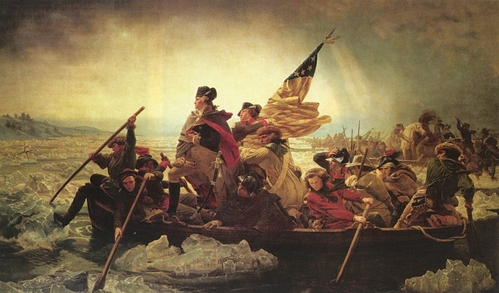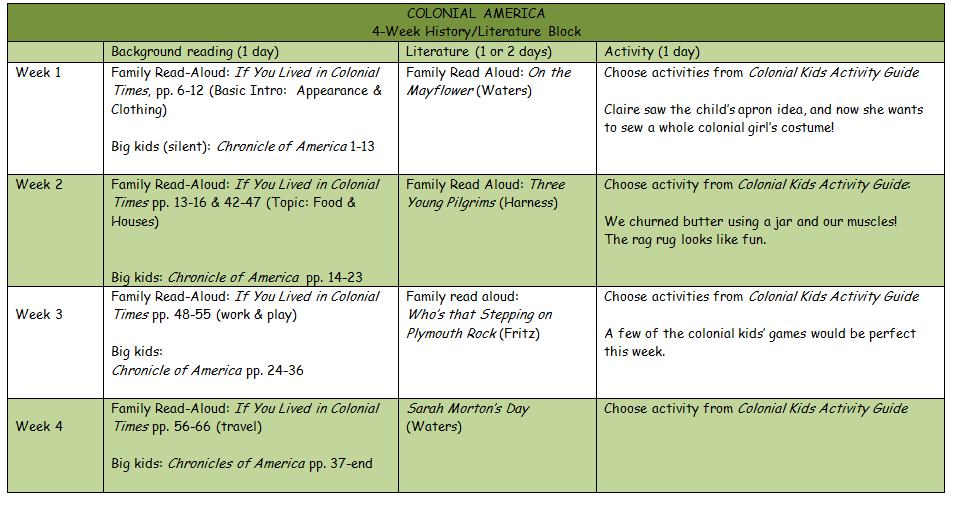
COLONIAL AMERICA 4-WEEK FAMILY LEARNING BLOCK
A. GENERAL INSTRUCTIONS
I include both non-fiction and fiction selections each week, supplemented by activities.
Large Families:
Families with several children develop their own methods for group instruction, but here is what we do:
- Aidan (age 13) listens to the family read aloud selection along with his siblings, or he may take the lead and read it aloud to them. I assign him one extra book to read during the study blocks. (So he had one extra “big kid” book to read during this 4-week block.)
- Claire (age 8) helps to read the book aloud in order to practice her reading skills.
- Dominic (age 5) listens while playing on the floor quietly or coloring/drawing.
Narrations and Writing:
- After we finish a family reading, I start with the youngest and listen to them tell me aloud what they learned or remember from the story. I will sometimes ask them to tell Dad what they learned when he returns home from work. This reinforces the lesson for them and brings Dad into the family learning experience.
- Dominic (5): I keep things very casual for Dominic, as he is a late bloomer. I offer him an opportunity to color a page or make a drawing inspired by something we’ve read, and to participate in the activity of the week, but these are not required. He often surprises me and comes up with a project on his own. When we studied Jamestown, he built a Lego replica of one of the ships!
- Finding coloring pages: You can either do a google search for
Colonial America coloring pages or purchase one of Dover’s beautiful coloring books for this period. Both are available for $3.95 on Amazon.com: The Story of the Pilgrim and Life in Colonial America
- Finding coloring pages: You can either do a google search for
- Claire (8):
- Narrations: Once a week I write down Claire’s narration and she may illustrate the page. She will often find inspiration in one of our books or from one of the coloring books listed above. We place this page in her Book of Centuries. This year she will begin the process of writing her own narrations, but she isn’t quite ready yet.
- Copywork: Once a week I also select one or two sentences from our reading and write it down neatly on our whiteboard. Claire copies
it in her best handwriting on handwriting paper. - Dictation: Usually the day after Claire has done her copywork, I dictate the same sentences aloud to her while she writes them down. I give lots of hints about important grammatical rules and challenging spellings in the dictation selection!
- Aidan (13) writes book summaries for the “big kid” books I assign him to read. Other families may require essays on the reading, but Aidan is taking a separate on-line writing course so I keep the rest of his writing assignments pretty light.
B. BOOK LIST
1. BOOKS READ THE ENTIRE 4 WEEKS (we read a portion of these books each week):
FAMILY:
- Non-fiction background: If You Lived in Colonial Times(Ann McGovern)
- If your youngest child is 7 or older, you might prefer Daily Life in the Pilgrim Colony (Paul Erickson). Terrific photos and written at a slightly higher reading level.
- Project ideas: Colonial Kids: An Activity Guide to Life in the New World (Carlson)
- We chose one project roughly each week (some projects may take longer than a week). Don’t get bogged down in projects!
- This book features projects in many areas, including food, crafts, games, and clothing.
BIG KIDS (grades 3-5) optional silent reading: I didn’t require Claire to do any additional silent history reading during this learning block, but a few suggestions if you need them:
- Squanto, Friend of the Pilgrims (Bulla) (chapter book; short historical fiction), or
- The Pilgrims at Plymouth (Penner) (an illustrated Landmark Book)
EVEN BIGGER KIDS (grades 6-8) additional silent reading:
- Chronicle of America: Colonial Times (Joy Masoff)
2. WEEKLY LITERATURE SELECTIONS
Week 1: On the Mayflower (Waters)
Week 2: Three Young Pilgrims (Harness
Week 3: Who’s that Stepping on Plymouth Rock (Fritz)
Week 4: Sarah Morton’s Day (Waters)
C. OPTIONAL EXTENDERS:
Geography:
- All kids: label and color maps of the 13 Colonies. Memorize capitals.
- Older kids: study and discuss (either aloud or in writing) the three distinct regions of the early colonies (New England, Middle and Southern colonies).
Art Appreciation:
- Rembrandt: Rembrandt was active in the 1600s. We used the Rembrandt Picture Study Portfolio published by Simply Charlotte Mason.
- The 17th Century didn’t produce any notable American artists that I know of, but craftsman did produce beautiful practical wares. I borrowed some books from the library on 17th century American antiques to show the children examples of pewter work and furniture making.
Science History:
- Science in Colonial America (January): Fascinating book about the contributions of Colonial Americans in several areas of science, including astronomy and medicine.
D. Weekly Summary Chart
Download: COLONIAL AMERICA chart
